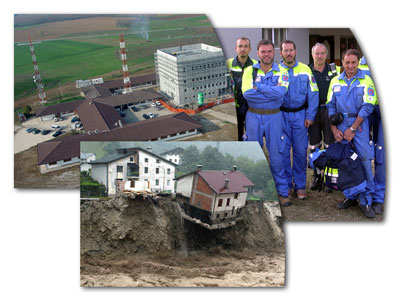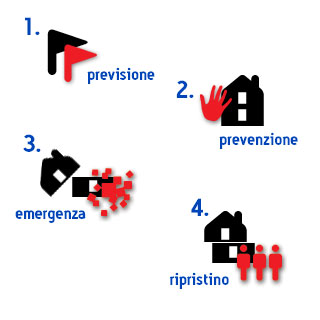What is civil protection?

A detailed description of Civil Protection is provided by Regional Law no. 64 of 31 December 1986 adopted by the Autonomous Region of Friuli Venezia Giulia, relative to the organisation of the civil protection system and regional civil protection measures:
“The Regional Administration takes upon itself the important task... to ensure the central coordination of all organisational measures and all actions, including data-collection, regulatory and administrative aspects ... in order to protect, within the safety framework of regional social security systems, the integrity of human life and/or property and the environment from any situation or event that is liable to cause serious damage or constitute a serious hazard to them and that needs to be addressed with extraordinary measures due to the type and magnitude of the hazard, and in order to deliver rescue services promptly.”
The individual elements of this detailed description provide some insight on the complexity of the civil protection system. Civil Protection:
- is a public service: civil protection is one of the key responsibilities of the Public Administration that must deliver a consistent and organised service, since civil protection can no longer be considered an incidental and occasional task as it was in the past, when different resources were gathered and deployed only when rescue actions had to be organised for the population in need;
- is a coordination task: coordination is possibly the most critical and strategically crucial aspect of civil protection, which cuts across all sectors of community life and needs to be coordinated effectively and efficiently in order to achieve its goals;
- is the coordination of organisational measures: the civil protection service may be defined as the organisational structure that has been set up for the organisation and implementation of solidarity measures at an administrative level (as set out in article 2 of the Italian Constitution: “The Republic recognises and guarantees the inviolable human rights, be it as an individual or in social groups expressing their personality, and it requests the performance of the unalterable duty to social, economic, and political solidarity.”);
- means coordinating all organisational measures and all actions, including data-collection, regulatory and administrative aspects: civil protection interventions have an impact on the most diverse facets of civil life and cannot be exactly predicted or comprised in abstract classifications, but regardless of whether they concern the collection and processing of information, lawmaking or operational and administrative issues, such interventions must be carried out with the highest possible degree of coordination and synergy;
- the purpose of civil protection is to protect the integrity of life and/or property and the environment: this is the scope of civil protection and its final goal, i.e. the protection of public safety;
- the civil protection service is called upon to intervene when any situation or event liable to cause serious damage or representing a serious hazard arises: the role of Civil Protection in case of overt threats and serious hazards jeopardising public safety is self-evident, but several decades of discussions and numerous disasters had to take place before it became fully clear and indisputable that Civil Protection has a key role to play also in case of imminent danger, when it should implement urgent prevention measures;
- the Civil Protection service steps in when extraordinary measures are needed, given the type and magnitude of the occurring events: the Civil Protection service takes action in extraordinary situations, whereas regular spatial planning activities fall outside its scope;
- it should also ensure rapid response actions: this is the activity most frequently referred to when talking about civil protection. Of course, disaster relief actions are crucial, but prevention measures are just as important, because they help reduce the number of necessary rescue actions.
Monitoring the environment and the impact of human action on it and on human communities should be an ongoing and regular effort by public powers. The ultimate goal of their interventions should be to protect the life of citizens while maintaining and fostering the development of their territory, as well as community life and economic activities. The prediction and prevention of disturbances to the community and the environment should be implicitly included among the ordinary management tasks of public powers. Civil Protection services are explicitly called to take action when natural disasters occur. However, damage is more limited and the response is more effective when civil protection objectives are taken into consideration in the ordinary business by correctly planning spatial development measures.
Civil protection measures.
Civil protection measures may vary widely and take different forms in order to best respond to disasters, as this is the crucial factor. By and large, they can be divided into four larger groups:
-
 Predictive forecasting: predictive forecasting is mostly a scientific activity aimed at researching and detecting the causes of disasters or determining the risks impacting on a given area, also in order to assess their likelihood of occurrence within a given timeframe;
Predictive forecasting: predictive forecasting is mostly a scientific activity aimed at researching and detecting the causes of disasters or determining the risks impacting on a given area, also in order to assess their likelihood of occurrence within a given timeframe; - Prevention and preparedness: on the basis of the knowledge obtained from the forecasting activity, prevention measures are implemented to avoid or mitigate disaster-related damages;
- Response and relief: includes any action taken to provide disaster-stricken populations with primary assistance and to mitigate the impact and effects of the disaster;
- Post-disaster recovery: actions aimed at restoring normal conditions after the disaster in order to enable populations to go back to their normal life as quickly as possible. These actions include for example technical interventions to restore territorial safety and awarding of contributions to private individuals and businesses to help them redress any damage.






